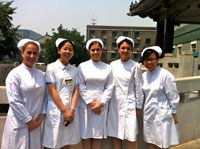What’s Old, is New, in Chinese Hospital Care, According to UNC Nursing Student Merle Tai
By Rick Docksai

Ever wondered what hospital care in the United States was like a few decades ago? You can get a pretty good idea if you visit a hospital in Beijing. University of North Carolina-Chapel Hill nursing student Merle Tai toured Peking Union Medical College and its hospital for three weeks. What she saw—simpler accommodations on one hand; but on the other, medical staff giving patients more personal time and attention—reminded her of American medical care as it once was.
“I felt like I’m seeing an older version of how American hospitals used to run. I’d see a lot of things and I’d say ‘we used to do that,’ or I’d hear someone else say ‘yeah, we used to do that,’” she said.
Chinese Medicine, Up Close and Personal
This wasn’t Tai’s first sight of China. She was born in Hong Kong and came to the United States with her family when she was three, and had made a few trips back to the old country since then. They included a 2007 study-abroad sojourn in Hong Kong, during which she enjoyed some recreational backpacking on the Chinese mainland. The Peking Union trip was, however, her first time viewing Chinese medical practice up close.
The trip, which ran from May 20-June 10, 2012, included Tai and three other UNC nursing students, and it culminated in the four delivering a presentation at the Beijing International Nursing Conference, which Peking Union hosted June 8-10. In the three weeks preceding this conference, Tai and her three colleagues stayed on campus, attended classes, and visited the PUMC hospital daily to follow its nurses as they went about their work.
Tai immediately recognized most of the nurses’ daily responsibilities: checking patients’ vital signs, delivering injections, drawing blood samples, etc. But a few additional tasks surprised her. For instance, she saw nurses guiding bedridden patients through physical-therapy routines.
American nurses conducted physical-therapy sessions, too, some 30 years ago, and only discontinued it as American medical practice in general grew increasingly specialized. Nowadays, American nurses leave physical therapy to occupational/physical therapists.
Tai thinks, however, that nurses’ involvement in physical therapy has some wisdom to it. For one thing, it might reduce incidence of bedsores, which patients suffer from if they stay in the same position in their beds for too long.

American nurses repeatedly turn patients over to prevent their getting bedsores. Tai was pleased to see that Peking Union’s nurses, meanwhile, were teaching patients to turn themselves over.
And generally speaking, a nurse can accelerate a patient’s recovery by teaching the patient some preliminary physical therapy, before the physical therapist even shows up. The patient can get moving and start rebuilding muscles sooner.
“If the patients are recovering and are too weak, there are little things that you can teach them while they are in bed, so that they can start gaining strength.” Tai said.
Elsewhere in the hospital, Tai saw a patient who had been in a coma for nine years and was still there. This, too, is something that one might have seen in an American hospital decades ago but not today: Present-day American hospitals rarely keep patients for more than a few hours, or perhaps a few days. A hospital with a patient in a long-term coma would likely hand him or her in a nursing home.
A Different Payment Model
Tai attributes these differences of practice to the fundamentally different financing and organizational model under which Chinese health care operates. First, China’s health-care system has far fewer specialists and specialized facilities, so its nurses and doctors all take on more responsibilities.
Secondly, China’s health-care system is a single-payer model in which the government directly pays the majority of the hospital bills for most of its citizens (Learn more about China’s Health Care System – This is a PDFD Doc.). On average, a Chinese citizen must pay for only about 35.5% of his or her medical costs out-of-pocket. This makes it affordable, Tai explains, for more Chinese families to keep loved ones in the hospital for longer periods of time.
Common Challenges
China’s fast-growing economy is fostering a rapid expansion in Chinese citizens’ incomes. As their consumption patterns catch up to the West, Chinese citizens are unfortunately picking up some of the West’s unhealthiest living habits.

Tai saw large numbers of patients coming in for heart-disease, diabetes, and blood-pressure-related conditions. These ailments are increasingly common in China, just like they are in the United States. Tai suspects that it’s for some of the same reasons: high-fat food and sedentary lifestyles. She recalls seeing a KFC on almost every corner of Beijing. Making matters worse, there were also heavier numbers of automobiles than she remembered from her previous visits—more cars means people walk less. Also in contrast to her previous visits to China, Tai saw many more obese people.
“I remember, the first time I was in China, not seeing a lot of obese people. But this time I saw it more and more,” she said. “You’re starting to see the effects of high-fat lifestyles and cars they’re already starting to effect the health system.”
A Pleasant Surprise
In all, however, Tai was quite pleased with her experience of Chinese hospital care. She admits that her expectations, prior to the trip, had not been totally positive.
“You turn on the TV here in the States, and every once in a while you’ll see some kind of 20-20 show expose some horrible medical practices going on in China. I didn’t exactly have a positive impression going in,” she said.
Yet the reality was far better than TV. She saw doctors and nurses working hard and making the best possible use out of limited resources for their patients’ health. It was an encouraging reminder to her of how China’s standards of living continue to rise.
“Every time I’ve gone to China, I’ve seen new growth and development,” she said. “Years ago, there wasn’t much going on. And every year I come back, the city gets a little bigger, and the streets get more crowded.”
One of Merle’s classmates and colleagues on this trip, Lauren McKenna, also shared her experiences and insight with us. Check out her article: Nursing in China and in America—UNC Student Lauren McKenna Explores How They are Alike and How They Differ